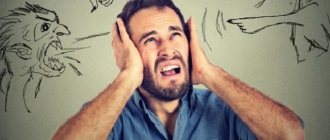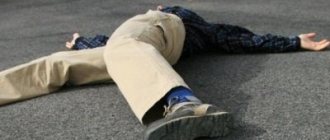What is idiopathic epilepsy
Idiopathic epilepsy is not formed due to organic damage to the brain by various injuries or previous illnesses. It occurs against the background of congenital predisposition as an independent disease.
The idiopathic form of epilepsy has been known for a long time, but despite this, scientists have not yet developed an effective treatment regimen that would help cure the disease. The disease develops in childhood from 4 to 18 years. Most often diagnosed in children at the age of ten.
Most of the established cases end favorably, and doctors are able to control seizures and convulsions.
On this topic
- Epilepsy
Everything you need to know about sleep epilepsy
- Natalia Sergeevna Pershina
- March 26, 2020
If the patient does not receive treatment for a long time, the disease can significantly reduce the quality of life. Children begin to develop disorders and their level of adaptation in society decreases.
Idiopathic epilepsy is easy to diagnose, and its symptoms are clearly expressed. With age, all signs and extent of the disease may change.
Classifications
In clinical practice, there are a wide variety of classifications of epilepsy in children: according to the time of first manifestations, the degree of spread of the pathological focus and etiological characteristics. At the same time, both forms of the disease and forms of seizures are divided into separate types.
- According to the time of first manifestations
There are childhood epilepsy (otherwise known as the benign or rolandic form) and adolescent epilepsy (otherwise known as the juvenile or myoclonic form).
Childhood epilepsy develops at the age of 3-6 years, has vague symptoms, gradually fades as the child develops and disappears without a trace under the influence of hormonal changes during puberty.
Adolescent epilepsy develops at the age of 8-20 years, occurs with the presence of exclusively myoclonic paroxysms and pronounced symptoms.
- According to the degree of spread of the pathological focus
Epilepsies can be partial or generalized. Partial forms are formed from a local epileptic discharge. Generalized forms – with symmetrical discharge activity in the absence of a specific focus.
- According to etiological characteristics
Epilepsies can be idiopathic, symptomatic or cryptogenic.
Idiopathic forms of the disease, as a rule, manifest themselves against the background of genetic developmental abnormalities, neuropsychiatric diseases or toxin poisoning. They are characterized by the presence of seizures without structural changes in the brain and are easier to treat than others with medication.
The symptomatic form develops against the background of diseases of the nervous system. It is characterized by symptoms depending on the area of brain damage. With pathology of the frontal lobe, convulsions lasting up to 30 seconds are often observed, affecting the upper body. When the temporal lobe is affected, unusual symptoms such as euphoria, sleepwalking and hallucinations occur. With the participation of the occipital lobe - defects of the optic nerves and rotation of the eyeballs towards the pathological focus.
The cryptogenic form is otherwise called hidden due to the difficulties in identifying the causes of the disease. It is characterized by rapid changes in metabolism, prolonged attacks repeated day and night, and drug resistance.
Causes
The main reason for the occurrence of this form of epilepsy is a mutation at the gene level and hereditary predisposition, which causes a disturbance in the conduction of impulses from nerve cells.
If one of the parents suffers from epileptic seizures, then the risk of developing the disease in the child is no more than 10%. The only exception is the symptomatic form.
Idiopathic epilepsy is diagnosed in 70% of cases and most often occurs in childhood. When seizures appear after 20 years, the cause of their occurrence may be abnormalities in the structure of the cerebral cortex.
Other causes of non-idiopathic epilepsy include:
- drug and alcohol addiction;
- various colds caused by infection;
- abnormalities in brain development
- cancer;
- psychological and neurological diseases;
- traumatic brain injuries.
Diagnosis of the disease in infants
Diagnosis of infantile epilepsy is somewhat difficult. First of all, it is necessary to differentiate true epileptic seizures from increased neuro-reflex excitability. The latter differs in that the movements of the limbs stop if they are held by hands.
To clarify the diagnosis, the following diagnostic methods are required:
- electroencephalogram;
- MRI, CT scan of the brain;
- Ultrasound of the brain.
These studies can detect cysts, neoplasms, hemorrhages, and dropsy.
EEG reveals foci of excitability. It should be carried out during sleep and wakefulness, since convulsive activity can only be recorded during sleep. In addition, it is necessary to conduct a blood test for the levels of glucose, potassium, sodium, magnesium, and protein.
Types
Experts identify the following types of idiopathic epilepsy:
- childhood and youth absence syndrome;
- benign convulsions, typical for infants
- photosensitivity;
- myoclonic congenital epilepsy;
- juvenile myoclonic;
- occurring with distant convulsive seizures.
On this topic
- Epilepsy
Everything you need to know about frontal lobe epilepsy
- Natalia Sergeevna Pershina
- March 26, 2020
Most parents incorrectly mistake febrile convulsions, which can occur in infants, as manifestations of epilepsy syndrome. In certain cases, children with this reaction experience a sharp rise in body temperature.
Over time, they are diagnosed with idiopathic epilepsy. But such cases are extremely rare. If only a single seizure is detected, it requires special observation. But after a secondary seizure, constant examination by specialists is necessary.
Clinical picture
There are several types of seizures.
They differ in the nature of their appearance, symptoms and duration.
Absence seizures
This type of seizure was first described in 1705. But the concept itself began to be used only in 1824. Absence seizures are characterized by loss of consciousness and delayed gaze.
According to statistics, idiopathic epilepsy, which is expressed in absence seizures, occurs in approximately 2 to 8 people out of 100,000. It occurs in girls twice as often as in boys.
With absence seizures, nine out of ten patients suffer from impaired motor activity. Approximately two thirds of patients suffer from uncontrollable repetitive behaviors. The course of the disease is considered complex when several manifestations of this type of congenital epilepsy are combined.
When tracking absence seizure on the EEG, one can see bilateral synchronous complexes, which are recorded at a frequency of 3 Hz. In this case, the largest peak value is the waves in the frontal parts. The minimum is observed in the temporal and occipital regions. But these data do not mean that the focus of activity is located in the frontal lobe of the brain.
Complexes are quite pronounced only over one hemisphere, which changes the prevalence in its direction. In addition, in 40% of patients, discharges are recorded in the stage between seizures and on the EEG.
The duration of each seizure is three minutes. Children may exhibit atypical absence seizures, interrupted by various factors.
Myoclonus
Congenital epilepsy with myoclonus often manifests itself as involuntary contractions of muscle tissue. In certain cases, it may be accompanied by joint motor activity. This type of seizure can be either focal, for one muscle group, or generalized.
Absolutely every convulsion corresponds to a discharge on the electroencephalogram. In some cases, myoclonus may have a negative form. At the same time, activity continues under the influence of gravity, at the moment of a sharp decrease in the tone of muscle tissue.
Generalized tonic-clonic
A tonic-clonic seizure is characterized by a successive phase of constant contractions that are followed by continuous contractions. Most often, the patient loses consciousness. The long-term tone phase lasts up to 40 seconds. Then rhythmic and sharp twitching begins.
The attack ends with complete relaxation, resulting in weakness. In rare cases, the patient may fall asleep. Involuntary urination and excessive salivation are often observed.
Today, doctors consider epilepsy not only as a disease characterized by seizures. Epilepsy is studied as a disease that causes global harm to the entire body, causing a wide range of neuralgic, somatic, mental disorders and changes. Epilepsy most often manifests itself ; the disease can appear in newborns and adolescents. There are many reasons for its occurrence - from congenital factors to the consequences of injuries. Each of them undergoes a thorough analysis to identify the form of epilepsy that they encountered.
Of all people suffering from the disease, epilepsy in children accounts for 70% of the total, so the disease is rightfully recognized as one of the leading diseases in pediatric neurology. It has been scientifically proven that the earlier the problem is diagnosed and treatment is started, the more successful and faster the result is. Since not every parent is able to identify epilepsy in children , adults need to know the main symptoms of the disease, which should alert them and become a good reason for going to the doctor.
Epilepsy in children - diagnosed by a doctor
Parents should refrain from making a diagnosis on their own, even in cases where they are absolutely sure that their child suffers from epilepsy. Moreover, it is unacceptable to independently determine the medications needed to take, despite the fact that their lists and dosage are indicated in specialized literature. To make an accurate diagnosis, you need to visit a specialist neurologist or epileptologist, tell him about the alarming factors, answer the questions in as much detail as possible and undergo the recommended examination.
What reasons most often make one suspect epilepsy in children and become the reason for a visit to the clinic? Among them:
- Sleep disorders - night sleep is the most sensitive indicator of the state of the central nervous system, so disruptions in sleep patterns often signal poor health. If a child takes too long to fall asleep or, on the contrary, wakes up, there is reason to worry. Please note that if the baby tosses and turns for a long time before going to bed, his whole body shudders during the period of falling asleep. When waking up, you should be alert to the child’s confusion, lack of understanding of where he is, and a long time to come to his senses. Often a reason to suspect epilepsy in children is such disorders as constant awakenings, screaming, laughing, crying, talking in their sleep, and sleepwalking. Even if there are no other signs, this is a serious reason to contact a neurologist. Adolescence is characterized by the presence of nightmares, which result in increased sweating and increased heart rate. In the morning, it is difficult for such a child to wake up, it takes him a long time to come to his senses, he is characterized by a lack of vigor, lethargy and a state of chronic fatigue.
- Increased fatigue, disturbances in the memorization process, groundless capriciousness, and distracted attention will help to suspect epilepsy in children
- One should be seriously wary of attacks of causeless lightheadedness, frequent mood swings, and incomprehensible pain throughout the body.
- If your child does not recognize places familiar to him or he often has a feeling of déjà vu, when it seems to him that he has been to a previously unvisited place, then this is also a sign for going to a neurologist.
It must be remembered that epilepsy in children occurs 3 times more often than in adults. If the disease is detected at an early stage, it can be completely cured. Parents do not want to believe until the last moment that it is their child who has encountered the disease, but they should remain calm and try to make every effort to save the child from the insidious disease.
Forms of epilepsy in children
The forms distinguish between symptomatic epilepsy in children , when seizures are caused by structural defects of the brain (hemorrhage, tumor, cyst), idiopathic with a hereditary predisposition to the occurrence of the disease (sometimes after several generations), and cryptogenic - with an unidentified cause of seizures. It is a mistake to believe that epilepsy in children is a death sentence for well-being for the rest of their lives. Today, medicine has reached great heights in the correction of illness. Recovery occurs in 70% of cases. This is especially typical when parents do not delay contacting a doctor, do not try to interfere with the prescribed treatment, and follow all the recommendations of specialists.
Signs of epilepsy in children - what are the types of seizures?
to detect epilepsy in children than in adults. In infants it often resembles simple motor activity. In addition, the disease is not always characterized by convulsive symptoms. And epilepsy does not exist in nature as a single disease. This is a whole complex of diseases with different clinical manifestations, which includes more than 60 types of diseases. All this makes diagnosis difficult in the early stages. However, there are still common symptoms:
Generalized attacks with convulsions are accompanied by short-term interruptions in breathing and sudden tension in the muscle corset. With this form of epilepsy, children experience seizures that last from 10 seconds to 15 minutes. Their duration may vary. During an attack, involuntary urination and defecation may occur, since the sharp relaxation of muscles following the tension creates all the prerequisites for this. After the attack ends, the child falls asleep, so it is very important to give him peace and time for the body to recover naturally.
Generalized seizures without convulsions , otherwise called absence seizures, are not so noticeable. to suspect epilepsy in children with absence seizures, since during an attack the child simply freezes, plunges into a state of thoughtfulness and a short stupor. His gaze becomes empty, sometimes twitching of the eyelids and throwing his head back appear. Trying to attract the child's attention at this moment, you will encounter a complete lack of reaction on his part. This state lasts no more than 20 seconds, so it is often mistaken by parents for ordinary absent-mindedness. At the end of the attack, the baby returns to the interrupted activity, as if nothing distracted him. Absence seizures are characterized by epilepsy in children aged 5-6 years. Moreover, girls are more susceptible to this form of the disease than their peers, boys. This type of disease is recorded in them twice as often. Absence epilepsy continues in children until puberty. Then a hormonal imbalance causes the disease to cease or transition to another form.
An atonic attack is manifested by a sudden loss of consciousness by the child, similar to fainting. If this condition recurs, you should consult a doctor immediately.
Infantile spasms are typical for children 2-3 years old. By the age of five they pass or change into another form. Spasms appear in involuntary movements when the child presses his arms to his chest, tilts his head or body forward, straightens his legs unnaturally. Sometimes the manifestation is expressed in an unnatural and prolonged nodding of the head.
Other signs of the disease may include:
- headaches, which include nausea and vomiting;
- speech disorders, when the child cannot speak for some time;
- nightmares and sleepwalking.
There is no need to sound the alarm if there are single signs indicated above. But if the symptoms recur with a certain frequency, then it is worth contacting a neurologist to rule out epilepsy in the child or confirm the diagnosis and prescribe treatment in a timely manner. The specialist will conduct a visual examination and prescribe electroencephalography, magnetic resonance or computed tomography.
You should undergo tests recommended by your doctor, since one of the signs of epilepsy in children is a lack of certain microelements in the body. This was first stated by neurologist Andre Barbois in 1973. He noted that a lack of zinc and magnesium in the body can provoke a convulsive attack. Even if this disadvantage is only temporary. To diagnose the level of microelements in the blood, it is necessary to undergo tests in a specialized laboratory. Based on them, the doctor can draw appropriate conclusions when prescribing treatment.
Treatment of epilepsy in children - correction methods
It is very important to determine the root cause of epilepsy in children in order to be able to prescribe competent and targeted treatment for the disease. In pharmacology, there are a large number of drugs that have anticonvulsant effects. Each medicine is effective for one form or another of epilepsy. There is no single dosage form that is equally effective for all patients.
Anticonvulsants are most often prescribed when multiple attacks occur, after which immediate results are observed in 30% of cases. In severe forms of the disease, the frequency and intensity of its manifestations decrease. The doctor begins prescribing the drug with a small dose, gradually increasing it if the effect planned by the therapy is not achieved. Parents should be prepared for the fact that epilepsy in children can take several months to several years to treat. You shouldn’t expect a quick cure for the disease; in some cases, it can be present in a person’s life for decades. It is important not to give up and believe in a successful outcome, since the internal state and belief in victory serve as a serious help in activating the body’s defenses.
Features of the flow
Childhood congenital absence epilepsy is diagnosed before the age of 10 years. Most often in children from 3 to 5 years old. Girls suffer from this type of disease more than boys. According to statistics, 3% of episodes of idiopathic epilepsy are preceded by febrile convulsions.
Most children have a complex course of the disease. It is usually accompanied by convulsions and motor automatisms. But in a certain group of patients, a sequence of complex and simple attacks occurs.
Provided effective and early treatment, the prognosis for this type of epilepsy is favorable. By the age of 15, in this case, the possibility of stopping absence seizures is quite high. But if left untreated, even simple seizures can give way to tonic-clonic ones.
On this topic
- Epilepsy
8 Facts About Myoclonic Epilepsy
- Natalia Sergeevna Pershina
- March 26, 2020
Juvenile congenital absence epilepsy occurs in combination with generalized seizures. It is detected more often at 9–12 years of age. In adolescents from 13 to 20 it is diagnosed in rare cases.
Myoclonic benign epilepsy first appears between the ages of one and a half years. But it can occur from 4 months to 3 years. With insufficient sleep and sudden awakening, seizures appear much more often. Psychological and mental development does not suffer if antiepileptic medications are started on time.
Juvenile myoclonic idiopathic epilepsy is characteristic of children and young men from 8 to 26 years old. The peak of the disease occurs at 14-15 years of age. In certain cases, early absence seizures may be a precursor. Often myoclonus develops into a generalized seizure.
An epileptic seizure can be triggered by a rapid change of pictures on the phone or TV screen, lack of sleep, flashing lights, anxiety, menstruation, or a sudden awakening.
On this topic
- Epilepsy
7 types of operations to get rid of epilepsy
- Natalia Sergeevna Pershina
- March 26, 2020
But the disease is most often resistant to drug therapy. That is why the possibility of worsening, increased frequency of seizures and a complicated course is quite high.
Seizures with photosensitivity congenital epilepsy can begin:
- when watching TV;
- while playing on a computer or game console;
- under the influence of flashes of color music;
- as a result of the flickering of the sun's through the branches or leaves of trees;
- when quickly moving to a light room from a dark one or vice versa;
- due to reflection of light from snow, ice, mirrors.
At the same time, the intellectual development of patients does not suffer. Patients often present with headaches, fear of light, and pain in the eyes in strong light.
Isolated generalized epilepsy with convulsive seizures occurs in adolescents from 10 to 18 years of age. It is expressed by characteristic attacks and has a favorable prognosis.
Stable remission can be achieved in 95% of diagnosed cases. After 3–4 years of seizure-free treatment, medications are completely discontinued.
Long-term prognosis and prevention of epilepsy
Epilepsy detected at an early age has a favorable prognosis for treatment. In newborns, the pathology responds well to therapy, and at an older age it is possible to reduce the number of seizures to a minimum. During adolescence, it will also be possible to control seizures with medications.
Doctors speak of stable remission if attacks do not occur for more than four years and no abnormalities are detected in the EEG results. In this case, all medications are canceled, but the nutrition plan and exercise restrictions are maintained. In more than half of patients, after such a long absence of seizures, exacerbations do not recur.
Disability status is assigned to a child depending on the type of pathology and the characteristics of the course of the disease. The second group is obtained for severe mental impairment and frequent attacks of epilepsy. Almost all sick children can receive the third disability group. With competently prescribed treatment, the psychological development of patients remains normal, so attendance at secondary schools and kindergartens is indicated.
The main preventive measure for the development of congenital epilepsy is taking care of your health even before pregnancy. You should avoid stress and mental stress, monitor your diet, and eliminate exposure to alcohol and nicotine. Mother's milk is very valuable for newborns. Breastfeeding also reduces the risk of developing pathology.
The appearance of even isolated seizures in a child should be a reason to immediately consult a doctor. Timely diagnosis of epilepsy and competent therapeutic measures will reduce the number of epileptic seizures, as well as significantly make the lives of children easier.
Diagnostics
The primary diagnosis of congenital epilepsy involves the use of an electroencephalogram. To get a complete picture, readings are taken during a seizure.
On this topic
- Epilepsy
Everything you need to know about epilepsy in adults
- Natalia Sergeevna Pershina
- March 26, 2020
To confirm the diagnosis, magnetic resonance imaging and computed tomography are performed. In cases of suspected benign or malignant tumors, positron emission tomography is performed.
The final diagnosis is established based on:
- Symptoms. Doctors recommend installing video cameras in the room where the patient is most often located. They are needed to record symptoms during seizures. The data greatly facilitates the determination of the type of attack.
- Assessment of intellectual and physical level of development.
- Interpretation of plasma karyotype analysis
- history .
Some difficulties in diagnosis arise when examining infants with unclear symptoms. In this case, the doctor prescribes standard therapy under the supervision of specialists.
First aid during an attack
- If necessary , place the child in a safe place where he or she will not be harmed.
- Provide air flow;
- Turn your baby's head to the side to prevent vomit and tongue from getting into the windpipe.
In case of a prolonged attack, it is necessary to call an ambulance . There is no need to insert different objects into the child's mouth. You should also not try to stop the seizure.
Treatment
When idiopathic epilepsy is diagnosed, drug therapy using antiepileptic drugs is prescribed. Initial monotherapy involves the use of valproic acid.
Tonic-clonic attacks can be cured by acid in 70% of cases. In addition, it effectively treats myoclonus and eliminates subclinical discharges.
In addition to valproic acid, congenital epilepsy can be successfully treated with Topiramate and Levetiracetam.
On this topic
- Epilepsy
5 facts about epilepsy after head injury
- Natalia Sergeevna Pershina
- March 26, 2020
Survey results show that Levetiracetam is an effective treatment for juvenile myoclonic epilepsy, as well as some forms of congenital epilepsy.
The medicine should be taken with caution, as in certain cases it has promyoclonic activity.
Clonazepam is used in the treatment of congenital epilepsy. If the use of these drugs does not bring the desired result, doctors use rational combinations.
After attacks with complications, it is imperative to give the body a rest and restore the functioning of systems and organs. Correctly prescribed therapy will help to significantly improve the patient’s well-being and reduce the risk of developing serious consequences. Preventive measures include covering one eye, blue sunglasses, a TV screen with a frequency of 100–200 Hz, maintaining a distance of 2 m from the TV, a large screen illuminated by a separate lamp.
What is prohibited
Most doctors believe that when congenital epilepsy is diagnosed, the patient must refuse:
- Alcoholic drinks.
- Coffee and tea.
- Smoking tobacco.
Your doctor may also prescribe a ketogenic diet. It is aimed at reducing seizures. You need to start such a diet with fasting, while drinking enough liquid.
Experts advise using still water. From the fourth day of the diet, it is allowed to introduce some foods into the diet. All food should be high in fat. People with established congenital epilepsy are considered disabled and have a number of restrictions regarding work.
People diagnosed with epilepsy should not work:
- With computer technology.
- On production lines.
- With chemicals or water.
- With high or low temperatures.
- With areas of fire or inflammation.
On this topic
- Epilepsy
All about cryptogenic epilepsy
- Natalia Sergeevna Pershina
- March 26, 2020
To prevent the patient from harming himself during seizures, some recommendations must be followed:
- Visit the sanatorium every year .
- Visit swimming pools or open water only in the presence of other persons.
- Limit the use of sharp objects.
- Walk outside every day
- Exercise regularly .
The number of patients diagnosed with epilepsy is growing every year. Diagnostic methods and methods of treating the disease are also being developed.
If you have established idiopathic epilepsy, do not panic. Correct and timely treatment in most cases leads to remission. Thus, patients have every chance to return to their normal lives.
Is epilepsy treated in children?
First of all, before starting treatment, parents need to provide their baby with a gentle regime . Limit possible overloads and stress as much as possible, reduce the time spent at the computer.
The diet for epilepsy does not provide for any special nutrition. It will be enough to limit your intake of liquid and salt.
Parents should understand that drug treatment for this disease lasts a very long time, and may even be lifelong. Each drug is selected individually for the child.











